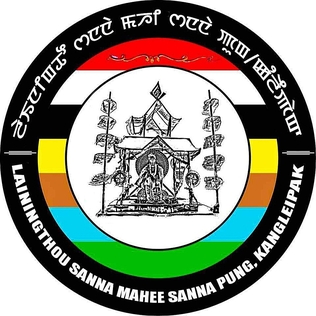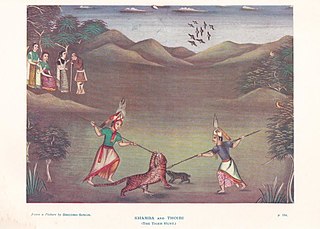Indian literature refers to the literature produced on the Indian subcontinent until 1947 and in the Republic of India thereafter. The Eighth Schedule to the Constitution of India has 22 officially recognised languages. Sahitya Akademi, India's highest literary body, also has 24 recognised literary languages.

Meitei, also known as Manipuri, is a Tibeto-Burman language of northeast India. It is the official language and the lingua franca of Manipur and one of the official languages of Assam. It is one of the constitutionally scheduled official languages of the Indian Republic. Meitei is the most widely-spoken Tibeto-Burman language of India and third most widely spoken language of northeast India after Assamese and Bengali. There are 1.76 million Meitei native speakers in India according to the 2011 census. Most of these, or 1.52 million, are found in the state of Manipur, where they represent majority of its population. There are smaller communities in neighbouring Indian states, such as Assam (168,000), Tripura (24,000), Nagaland (9,500), and elsewhere in the country (37,500). The language is also spoken by smaller groups in neighbouring Myanmar and Bangladesh.

Meitei literature, also known as Manipuri literature, is literature written in the Meitei language of Manipur. An ancient institution of learning, the Luwang Nonghumsang, later known as the Pandit Loishang, collected sources of indigenous Meitei knowledge and philosophy until the 18th century. Writing by Meiteis is assumed to go back to the Kingdom of Kangleipak in the early 12th century. The Meitei script is a Brahmic abugida. It is known only from the Puya manuscripts discovered in the first half of the 20th century. Manuscripts of the 18th and 19th centuries were written using the Bengali alphabet. The existence of the Meitei script in the 15th-century hinges on the authenticity of an inscription dated to the reign of Senbi Kiyamba. The first printed Manipuri book, Manipurer Itihas, appeared in 1890 from the Baptist Mission Press, Calcutta. Though the kings of Manipur had established contact with the British from the middle of the eighteenth century onward the real impact of the contact came much later. Johnstone Middle English School, based on the western system of education, was started in 1885 at Imphal, and in 1891 Manipur lost its independence to the British. British domination facilitated the introduction of new systems in the civil, political and educational spheres, which hastened the process of modernization in Manipur, exposed as it was to new ideas and influences.

The Manipuri Sahitya Parishad is a literary council dedicated to the active promotion and the development of literary works in the Meitei language in India. in national as well as international levels. It has its branches in the Manupur cities of Imphal, Jiribam, Bishnupur and Thoubal inside Manipur and in Tripura and Meghalaya in Assam.

Nongshaba is a lion god in Sanamahism and Meitei mythology. He is also regarded as a king of the gods. He is credited with producing light in the primordial universe and is regarded as the maker of the sun. He is worshipped by the people of both the Ningthouja clans as well as the Moirang clans. Nongshaba was worshipped by the people of Moirang clan as a lineage deity and regarded as the father of the god Thangching. He is the greatest of the Umang Lais but he made his only son Thangching the chief deity of Moirang.
The Khamba Thoibi Sheireng, also spelled as the Khamba Thoibi Seireng, is a Classical Meitei language epic poem based on the ancient love story of Khuman prince Khamba and Moirang princess Thoibi of Ancient Moirang kingdom of Ancient Kangleipak. It is the magnum opus of Hijam Anganghal, the "Bard of Samurou". It is regarded as the national epic of the Manipuris. It is regarded as the greatest of all the epic poems in Meitei literature, with 39,000 verses, thereby being the third longest Indian epic poem, next to the Mahabharata and the Ramayana.

Yumjao Leima or Yumjao Lairembi or Yumjao Lairemma is the mother goddess of house, household, royalty, rule and power in Meitei mythology and religion. She is designated as the all time ruling Queen Mother. Legend says she assumes a human form in white clothes and blesses kings. She is one of the divine incarnations of Leimarel Sidabi.

The social movement of Meitei language to achieve the officially recognised status of the "Classical language of India" is advocated by various literary, political, social associations and organisations as well as notable individual personalities of Bangladesh, Myanmar, Northeast India.

The ancient legend of Khamba and Thoibi is a classic, as well as one of the epic cycles of incarnations of Meitei mythology and folklore, that is originated from Ancient Moirang kingdom of Ancient Kangleipak . It is referred to as the "National Romantic Legend of Manipur" by Padma Vibhushan awardee Indian scholar Suniti Kumar Chatterjee.
The Nongmaiching Ching, also known as the Selloi Langmai Ching, is a mountain in Imphal Valley, Manipur. It has an altitude of around 5,133 feet (1,565 m). It is a holy pilgrimage site for the Meitei people. In Meitei mythology and religion (Sanamahism), it is a sacred mountain and the abode of God Nongpok Ningthou and Goddess Panthoibi. In Meitei folklore, the Nongmaiching is described as the hill that produces "the seven days of a week".

The Lainingthou Sanna Mahee Sanna Pung, Kangleipak, also known as the Lainingthou Sanamahi Sanapung (LSSP), is a non-governmental organization of the followers of the Sanamahism, dedicated to God Lainingthou Sanamahi and other ancient Meitei deities of Kangleipak.

Khamba Thoibi Jagoi, also known as Khamba Thoibi classical dance or Khamba Thoibi ballet, is a traditional Meitei ritualistic and theatrical classical dance form, which is usually enacted as a part and parcel of the Lai Haraoba performances, dedicated to God Thangching, the national deity of Ancient Moirang realm. Notably, it is one of the cultural elements, giving inspirations to the development of the Manipuri Raas Leela classical dance drama form.

The Khoirentak tiger was a vicious monster in Meitei mythology that lived in Khoirentak. It was eventually killed by Khuman Khamba. The tiger caused havoc to the people of the Khoirentak in Ancient Moirang, thereby becoming the "man eater" of the region. Finally, Khuman Khamba and Nongban were ordered by the king, to catch the beast. In the first encounter, Nongban was killed by the tiger and at the final meet, Khuman Khamba successfully captured and killed it. Finally, when he brought it to the capital city of Ancient Moirang, Thoibi was given to him, hand in marriage.
Ningthou Kangba was a ruler of Ancient Kangleipak. He is traditionally seen as having invented Sagol Kangjei, the earliest form of the modern day polo sports. He was the son of King Tangja Leela Pakhangba (1445 BC-1405 BC) and Queen Sinbee Leima. He was the consort of Queen Leima Taritnu, daughter of a king named Nongpok Ningthou of the Nongmaiching Hill in the east of Imphal.
Meidingu Naophangba was a Meetei ruler of Ningthouja dynasty of Ancient Manipur. He is the successor of Naokhamba and the predecessor of Sameiraang. He promulgated a proto-Constitution in 429 AD, which later grew into the Loyumba Shinyen, a written constitution in 1100 AD, during the reign of King Loyumba. He is one of the most outstanding figures in the history of Meitei architecture of Ancient Manipur. He laid the foundation stone of the Kangla, the "Namthak Sarongpung", which is the holiest place to the Manipuri ethnicity. During his reign, the coronation hall in the Kangla was inaugurated and a hog was sacrificed. According to the Loyumba Shinyen, he took command from Mangang Luwang Khuman for the administration of justice in the kingdom. According to the Chakparol, the ten villages of the Chakpas separated during his reign. It was right from his reign that the newcomers (immigrants) were assigned and admitted to the yek salai (clans) and the yumnaks (families) of the Meitei ethnicity. According to the Thengkourol, copper and brass were imported from Burma and China during his reign.

The Loiyumpa Silyel, also termed as the Loyumpa Silyel or the Loiyumpa Shilyel or the Loyumpa Shilyel or the Loyumba Sinyen, is an 11th-12th century ancient Meitei language written constitution, regulated in the Ancient Kangleipak during the rule of King Loiyumba. In 1110 CE, its format was finalised from a promulgation of the proto-constitution, drafted in 429 CE by King Naophangba. Historically, it is the first written constitution, and one of the well recorded Ancient Meitei language texts of the kingdom. It was replaced by the Manipur State Constitution Act 1947, that was functional until Manipur was merged into Republic of India on October 15, 1949.

Women have significant roles in different elements of Meitei culture, including Meitei dances, Meitei festivals, Meitei folklore, Meitei folktales, Meitei literature, Meitei mythology, Meitei religion, etc.

Ancient Meitei literature, also termed as Old Manipuri literature, is literature written in the Old Manipuri language from the earliest texts until the time of King Pamheiba. All the ancient Meitei literary works are written in the traditional Meitei script. The ancient Meitei language texts, written in Meitei script, are conventionally termed as "the puyas".

The cultural heritages of Meitei civilization has classicism in diverse traditions of cinemas, dances, language, literature, music, theatre, etc.

The intangible cultural heritage (ICH) of Meitei civilization is recognised, honoured, preserved as well as promoted by the UNESCO, the Ministry of Culture of the Union Government of India, the Government of Armenia, the State Government of Manipur, the State Government of Assam, the State Government of Tripura, among many other notable institutions.






























